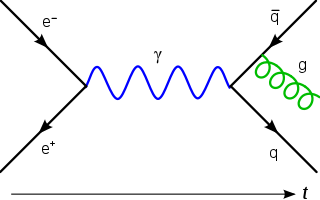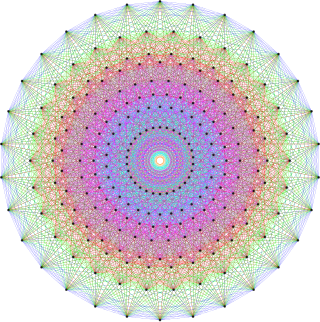
In mathematical physics and mathematics, the Pauli matrices are a set of three 2 × 2 complex matrices that are traceless, Hermitian, involutory and unitary. Usually indicated by the Greek letter sigma, they are occasionally denoted by tau when used in connection with isospin symmetries.
In particle physics, the Dirac equation is a relativistic wave equation derived by British physicist Paul Dirac in 1928. In its free form, or including electromagnetic interactions, it describes all spin-1/2 massive particles, called "Dirac particles", such as electrons and quarks for which parity is a symmetry. It is consistent with both the principles of quantum mechanics and the theory of special relativity, and was the first theory to account fully for special relativity in the context of quantum mechanics. It was validated by accounting for the fine structure of the hydrogen spectrum in a completely rigorous way. It has become vital in the building of the Standard Model.

In mathematics, the special unitary group of degree n, denoted SU(n), is the Lie group of n × n unitary matrices with determinant 1.
In mathematics, the Baker–Campbell–Hausdorff formula gives the value of that solves the equation for possibly noncommutative X and Y in the Lie algebra of a Lie group. There are various ways of writing the formula, but all ultimately yield an expression for in Lie algebraic terms, that is, as a formal series in and and iterated commutators thereof. The first few terms of this series are: where "" indicates terms involving higher commutators of and . If and are sufficiently small elements of the Lie algebra of a Lie group , the series is convergent. Meanwhile, every element sufficiently close to the identity in can be expressed as for a small in . Thus, we can say that near the identity the group multiplication in —written as —can be expressed in purely Lie algebraic terms. The Baker–Campbell–Hausdorff formula can be used to give comparatively simple proofs of deep results in the Lie group–Lie algebra correspondence.
In mathematics, a Casimir element is a distinguished element of the center of the universal enveloping algebra of a Lie algebra. A prototypical example is the squared angular momentum operator, which is a Casimir element of the three-dimensional rotation group.
In relativistic physics, Lorentz symmetry or Lorentz invariance, named after the Dutch physicist Hendrik Lorentz, is an equivalence of observation or observational symmetry due to special relativity implying that the laws of physics stay the same for all observers that are moving with respect to one another within an inertial frame. It has also been described as "the feature of nature that says experimental results are independent of the orientation or the boost velocity of the laboratory through space".
The Gell-Mann matrices, developed by Murray Gell-Mann, are a set of eight linearly independent 3×3 traceless Hermitian matrices used in the study of the strong interaction in particle physics. They span the Lie algebra of the SU(3) group in the defining representation.

Yang–Mills theory is a quantum field theory for nuclear binding devised by Chen Ning Yang and Robert Mills in 1953, as well as a generic term for the class of similar theories. The Yang–Mills theory is a gauge theory based on a special unitary group SU(n), or more generally any compact Lie group. A Yang–Mills theory seeks to describe the behavior of elementary particles using these non-abelian Lie groups and is at the core of the unification of the electromagnetic force and weak forces (i.e. U(1) × SU(2)) as well as quantum chromodynamics, the theory of the strong force (based on SU(3)). Thus it forms the basis of the understanding of the Standard Model of particle physics.
In quantum mechanics, the canonical commutation relation is the fundamental relation between canonical conjugate quantities. For example,

In physics, the eightfold way is an organizational scheme for a class of subatomic particles known as hadrons that led to the development of the quark model. Both the American physicist Murray Gell-Mann and the Israeli physicist Yuval Ne'eman independently and simultaneously proposed the idea in 1961. The name comes from Gell-Mann's (1961) paper and is an allusion to the Noble Eightfold Path of Buddhism.
In mathematics, a vertex operator algebra (VOA) is an algebraic structure that plays an important role in two-dimensional conformal field theory and string theory. In addition to physical applications, vertex operator algebras have proven useful in purely mathematical contexts such as monstrous moonshine and the geometric Langlands correspondence.
In mathematics, an affine Lie algebra is an infinite-dimensional Lie algebra that is constructed in a canonical fashion out of a finite-dimensional simple Lie algebra. Given an affine Lie algebra, one can also form the associated affine Kac-Moody algebra, as described below. From a purely mathematical point of view, affine Lie algebras are interesting because their representation theory, like representation theory of finite-dimensional semisimple Lie algebras, is much better understood than that of general Kac–Moody algebras. As observed by Victor Kac, the character formula for representations of affine Lie algebras implies certain combinatorial identities, the Macdonald identities.
In theoretical physics and mathematics, a Wess–Zumino–Witten (WZW) model, also called a Wess–Zumino–Novikov–Witten model, is a type of two-dimensional conformal field theory named after Julius Wess, Bruno Zumino, Sergei Novikov and Edward Witten. A WZW model is associated to a Lie group, and its symmetry algebra is the affine Lie algebra built from the corresponding Lie algebra. By extension, the name WZW model is sometimes used for any conformal field theory whose symmetry algebra is an affine Lie algebra.
In conformal field theory and representation theory, a W-algebra is an associative algebra that generalizes the Virasoro algebra. W-algebras were introduced by Alexander Zamolodchikov, and the name "W-algebra" comes from the fact that Zamolodchikov used the letter W for one of the elements of one of his examples.
In mathematics and physics, in particular quantum information, the term generalized Pauli matrices refers to families of matrices which generalize the properties of the Pauli matrices. Here, a few classes of such matrices are summarized.
In physics, the Gell-Mann–Okubo mass formula provides a sum rule for the masses of hadrons within a specific multiplet, determined by their isospin (I) and strangeness (or alternatively, hypercharge)
The Schrödinger group is the symmetry group of the free particle Schrödinger equation. Mathematically, the group SL(2,R) acts on the Heisenberg group by outer automorphisms, and the Schrödinger group is the corresponding semidirect product.

Symmetries in quantum mechanics describe features of spacetime and particles which are unchanged under some transformation, in the context of quantum mechanics, relativistic quantum mechanics and quantum field theory, and with applications in the mathematical formulation of the standard model and condensed matter physics. In general, symmetry in physics, invariance, and conservation laws, are fundamentally important constraints for formulating physical theories and models. In practice, they are powerful methods for solving problems and predicting what can happen. While conservation laws do not always give the answer to the problem directly, they form the correct constraints and the first steps to solving a multitude of problems. In application, understanding symmetries can also provide insights on the eigenstates that can be expected. For example, the existence of degenerate states can be inferred by the presence of non commuting symmetry operators or that the non degenerate states are also eigenvectors of symmetry operators.

In the theory of Lie groups, Lie algebras and their representation theory, a Lie algebra extensione is an enlargement of a given Lie algebra g by another Lie algebra h. Extensions arise in several ways. There is the trivial extension obtained by taking a direct sum of two Lie algebras. Other types are the split extension and the central extension. Extensions may arise naturally, for instance, when forming a Lie algebra from projective group representations. Such a Lie algebra will contain central charges.
A two-dimensional conformal field theory is a quantum field theory on a Euclidean two-dimensional space, that is invariant under local conformal transformations.








